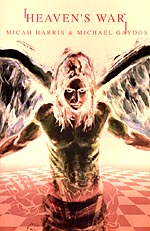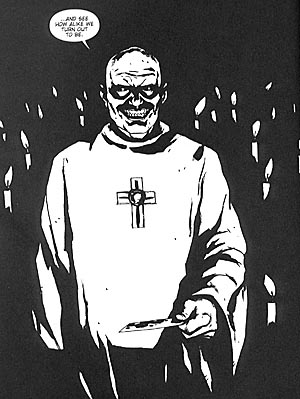 Written by Micah Harris
Written by Micah Harris
Art by Michael Gaydos
120 pages, black and white
Published by Image Comics
When Alan Moore and Kevin O’Neill debuted their series The League of Extraordinary Gentlemen, the book took off like a shot. Take a bunch of literary characters and have them work together to try and save the world from certain destruction. In many ways, then, Heaven’s War is the flipside of that idea. Instead of taking literary characters, writer Micah Harris has taken several literary authors that were linked together in real life—J.R.R. Tolkien, C.S. Lewis, and Charles Williams—and has them save the world. In concept alone, this seems to be a sure fire hit.
Charles Williams is summoned by legendary Tarot and Kaballah expert Arthur Waite with information of utmost importance. The twisted Aleister Crowley is going to use echoes of the original war in Heaven to reshape the entire world to his choosing. With Waite’s knowledge and the help of Williams’s fellow “Inklings” writers group members J.R.R. Tolkien and C.S. Lewis, can they stop Crowley from his otherwise certain victory?
When the film version of From Hell hit theatres, I heard one person complain that the infamous “carriage ride” sequence wasn’t in the movie. In From Hell, two characters go on a carriage ride through London, stopping at numerous landmarks where we learn the significance of each one. It’s only at the conclusion of this rather long journey that we see their route mapped out, forming a massive pentigram over the city. I argued at the time of the movie that unless you’ve got a writer the caliber of Alan Moore, that sort of scene would never translate into a movie because you’d bore your audience to death. What I should have said is that the same is true, to a lesser extent, in comics. Harris has clearly done considerable research into both the artwork and the geography of the time, linking up various Knights Templar legends and actual facts into a massive, cohesive hole that points the characters to the treasure that awaits them. The problem is, it’s immensely boring. The entire second chapter of Heaven’s War, some 30 pages, is devoted to just that and in doing so Harris loses his audience. The book starts off with a bang, but suddenly it’s a nightmarish merger of Art History 101 and a historical tour that you’re desperate to end. The narration in Heaven’s War tells rather than shows the reader everything; you’re constantly being lectured to, and the big climactic showdown between Crowley and Williams is about as exciting as watching paint dry as it just drones on… and on… and on… and on…
 Michael Gaydos is given a difficult task of making middle-aged men in their suits look exciting, something that could be a bit problematic. All things considered, he does a pretty good job. He’s able to bring a wonderfully sinister look to Crowley, and the entire first chapter from Williams’s summoning to the attack on Waite’s house comes across as really tense to follow. This is in part because of the heavy inks that Gaydos uses on his page; for a book that’s supposed to be thrilling and creepy, he knows how to use shadows and darkness to accentuate those traits. Watching Williams get swallowed up by the blackness of the cave, for instance, is a pretty creepy moment thanks to the art. I was also really impressed with just how much Gaydos is able to pack onto a page, with nine or ten panels being almost common-place. Coupled with some interesting layouts for the really exposition heavy pages (with little thumbnails of the pieces of art or historical event next to the paragraphs of information being dumbed on the reader), Gaydos certainly was the right choice to illustrate Heaven’s War.
Michael Gaydos is given a difficult task of making middle-aged men in their suits look exciting, something that could be a bit problematic. All things considered, he does a pretty good job. He’s able to bring a wonderfully sinister look to Crowley, and the entire first chapter from Williams’s summoning to the attack on Waite’s house comes across as really tense to follow. This is in part because of the heavy inks that Gaydos uses on his page; for a book that’s supposed to be thrilling and creepy, he knows how to use shadows and darkness to accentuate those traits. Watching Williams get swallowed up by the blackness of the cave, for instance, is a pretty creepy moment thanks to the art. I was also really impressed with just how much Gaydos is able to pack onto a page, with nine or ten panels being almost common-place. Coupled with some interesting layouts for the really exposition heavy pages (with little thumbnails of the pieces of art or historical event next to the paragraphs of information being dumbed on the reader), Gaydos certainly was the right choice to illustrate Heaven’s War.
I really wish that I could like Heaven’s War more from a writing standpoint; there are a lot of really fascinating ideas here courtesy of Harris. The idea of the light from the fall from grace just now reaching Earth is a great one, and with Harris’s appendices on display, it’s obvious that Harris has done an amazing amount of research. Hopefully future books won’t feel so much like it’s being force-fed to the audience. Still, a very attractive book if rather unwieldy.
Purchase Links:
